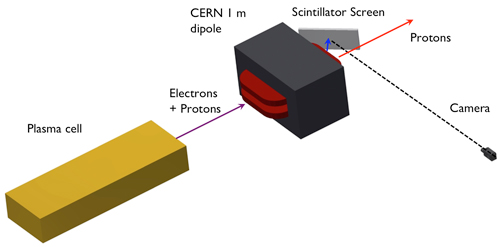AWAKE Diagnostics
Electron energy spectrometer
UCL is leading the design, build and commission of the magnetic spectrometer in order to measure the energy of the accelerated electrons after they have exited the plasma cell. The concept is shown on the right where a dipole magnet is used to bend the electron beam onto a screen with the much higher proton beam unperturbed by the magnet. The dispersion created by the magnet leads to an energy-dependent position spread on the scintillator screen which is imaged by a CCD camera placed away from the beams.

Using a magnet available at CERN, we will be able to vary the field and hence measure electrons in the energy range from the injection value of about 10 MeV up to the most optimistic accelerated value of 5 GeV.
Simulations are ongoing to determine the configuration of the system, position and tilt of the screen, magnetic field, etc. and the choice of scintillation material.
Photon acceleration diagnostic
In collaboration with CLF, RAL and Imperial, we are developing a diagnostic to measure the change in plasma density and hence electric field using the phenomenom of photon acceleration which combines space-like and time-like refraction effects. A co-propagating laser pulse is either red- or blue-shifted if at the front or back of the wakefield bubble and the frequency shift can be measured and is a powerful diagnostic for single-shot experiments like AWAKE (one proton bunch every 30 s). Preliminary experiments and development has been carried out using the ASTRA laser at CLF, RAL.
